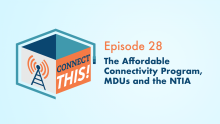Join Us Thursday, December 16th at 5pm ET for Episode 28 of the Connect This! Show
Join us live on Thursday, December 16th at 5pm ET for Episode 28 of the Connect This! Show, where co-hosts Christopher and Travis Carter (USI Fiber) will be joined by returning guests Doug Dawson (CCG Consulting) and Kim McKinley (UTOPIA Fiber) to catch up on the news of the week and check in on a number of issues.
The panel will discuss, among other things, the transition from the Emergency Broadband Benefit to the Affordable Connectivity Program, restrictive access and exclusive wiring agreements in apartment buildings, and where the NTIA is on administering the more than $42 billion in new broadband infrastructure.
Subscribe to the show using this feed, or visit ConnectThisShow.com
Email us broadband@muninetworks.org with feedback, ideas for the show, or your pictures of weird wireless infrastructure to stump Travis.
Watch here or below on YouTube Live, via Facebook Live here, or follow Christopher on Twitter to watch there.



